What Is A Manure Spreader?
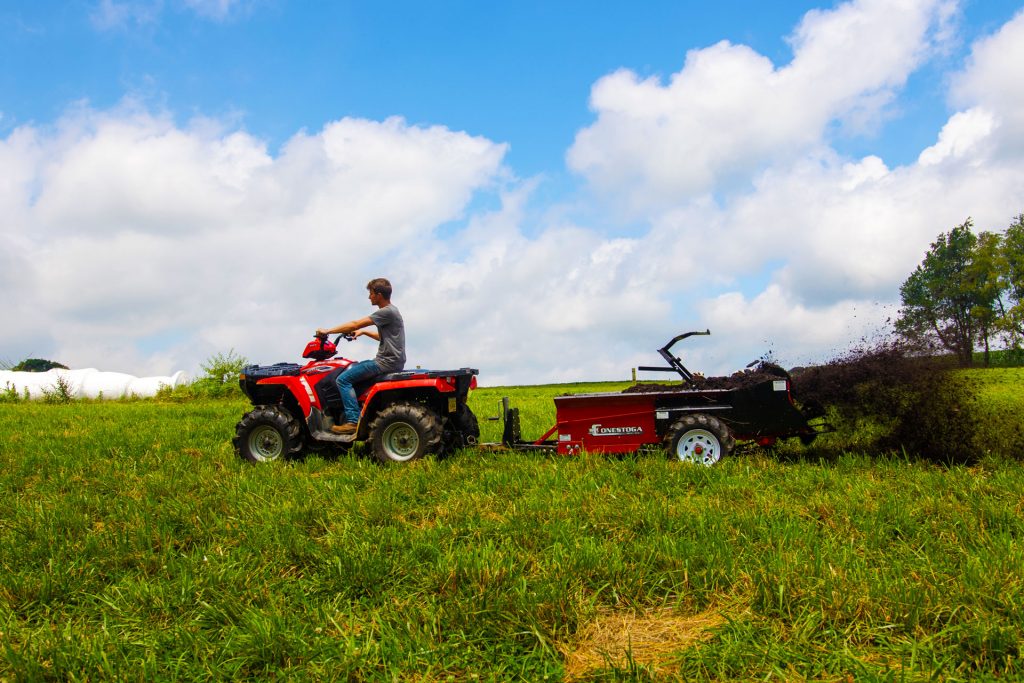
Manure spreaders are farm machinery that farmers use to spread around their animal’s manure. The spreading of manure on pastures and crop fields enriches the soil and disposes of unwanted manure. Before the invention of the manure spreaders, farmers had to shovel and spread their manure by hand. If you imagine spreading manure weekly with a wheelbarrow and shovel or pitchfork, you’ll realize how significant even a tiny manure spreader can be.
How Long Should A Manure Spreader Last?
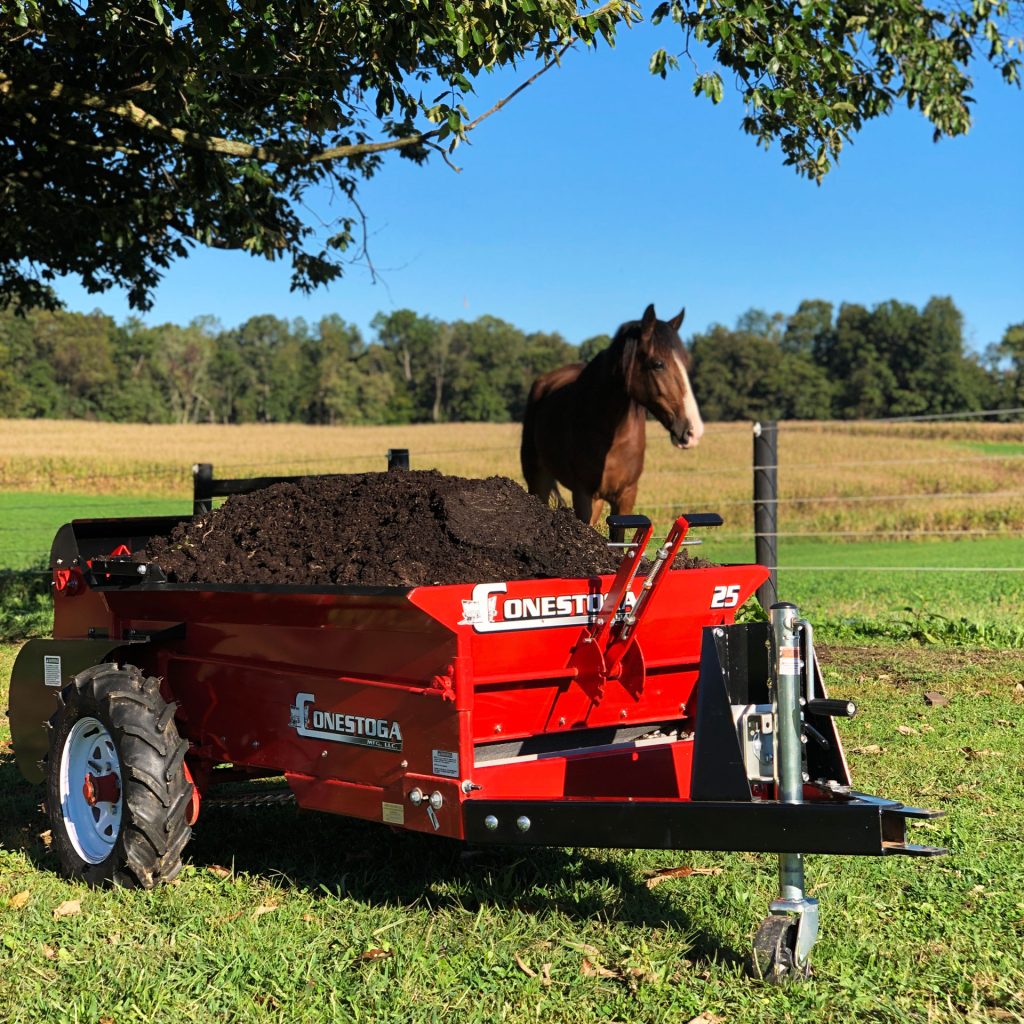
At the very least, you want your manure spreader to last as long as its individual working components – bearings, apron chain, sprockets, etc. The idea is that when one or more of these components goes bad, it is still advantageous to replace the individual part instead of buying an entirely new spreader.
We’ve built our manure spreaders to last up to 30 years without the spreader box rusting through because of the type of steel we use for every spreader box. This ensures you will get many excellent years of regular use from our machines. You will confidently be able to replace parts over the years, knowing that your manure spreader will hold up.
How Long Has Conestoga Been Making Manure Spreaders?

Conestoga has been building manure spreaders since 2002. We started by using regular A36 steel on the sides of our models CM-25, CM-50, C-50 PTO, and C-80 PTO, and 10-gauge cor-ten on the larger Model C-125 PTO. We introduced our largest PTO manure spreader in 2009, the C-175 PTO. That same year, we upgraded the steel we use for all of our smaller manure spreader models. Instead of using the A36 steel, we began using 12-gauge cor-ten steel for all the spreaders except the C-125 and C-175, which still get 10-gauge cor-ten steel.
Cor-ten is a corrosion-resistant, copper-bearing steel used by manufacturers of larger spreaders. In 2009, we started using 12-gauge Cor-ten steel for the side construction of models C-25, C-50, and C-80, and 10-gauge Cor-ten on the larger Models C-125 and the newly introduced C-175. Our research has shown that this special steel has increased the life of our spreader sides by at least 10 years, bringing their whole life, under regular use, to 22, 24, and even 30 years.
Regarding the apron chain, the early ones were made from the same A36 steel as the older sides. We have replaced some of those who have served 8 years without failure, but we weren’t satisfied. We began making the apron, slats, and chain out of stainless steel to increase apron life up to three times what it was with A36 steel. Sure, stainless steel aprons cost more, but they’re worth it because they are the heart of the spreader mechanism, and their longer life gives owners three times more downtime-free working hours.
What Is The Difference Between a PTO Driven Spreader And A Ground Driven Spreader
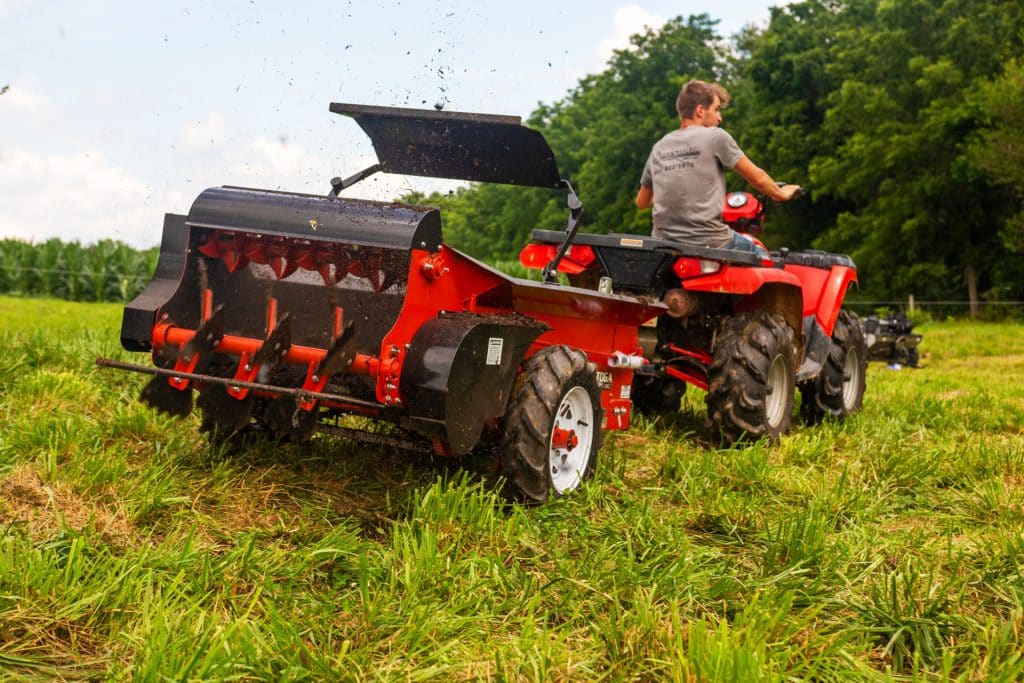
One manure spreader FAQ is “what exactly is a PTO manure spreader?” Speaking, PTO stands for “Power Take Off.” The PTO is a shaft on the rear end of a tractor that transfers power from the tractor to another piece of equipment, such as a manure spreader. So, a PTO spreader is operated by a tractor or ATV power.
A ground-driven manure spreader is a spreader that operates without a PTO (power take-off) drive. The beater paddles and apron chain that moves the material are connected to the spreader’s wheels. So, as you pull your ground-driven manure spreader, it will automatically spread your manure when the beater bar(s) and apron chain are engaged.
Are PTO And Ground Driven Manure Spreaders The Same?
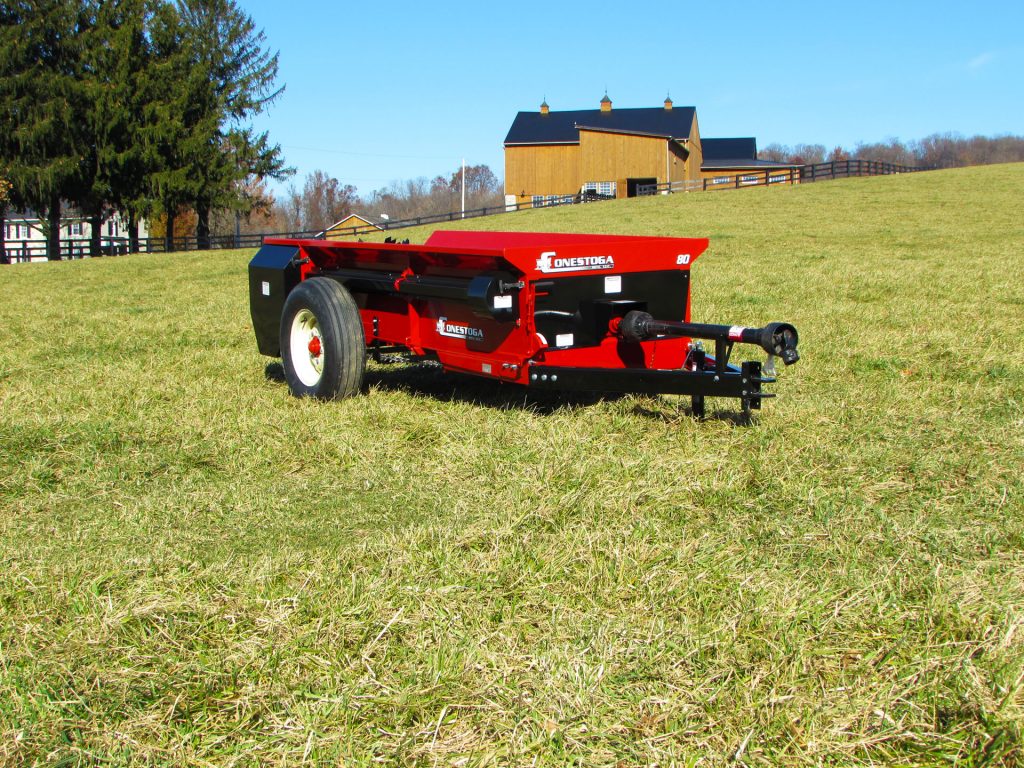
Typically you’ll find a PTO spreader is a larger-sized or heavier-duty spreader. A PTO spreader is excellent for large horse farms, farmettes, and small farms. You’ll likely have a larger capacity with a PTO spreader than with a ground drive spreader. And you get greater control over spreading speed and distribution. Although typically smaller, ground-driven manure spreaders are great because they are simpler to operate since they do not require a PTO connection to spread. All you have to do is hook up your ground-driven spreader and go!
If you’re considering which spreader suits your application, you’ll also need to consider size (how much you need the spreader to hold). This can be determined by the size of your operation (how much you will have to spread at one time) and the frequency with which you’ll need to spread manure (Daily? Weekly? Monthly?).
Many PTO spreader owners will tell you that it can be difficult to hook up to a tractor or ATV. A Conestoga spreader is easy to attach and can be done quickly.
A PTO spreader can help you reduce the time associated with manure spreading by as much as 50%. Before you purchase a PTO spreader, ask questions about how easy it is to hook up, how easy it is to operate, and how easy it is to clean.
Are PTO And Ground Driven Manure Spreaders The Same?
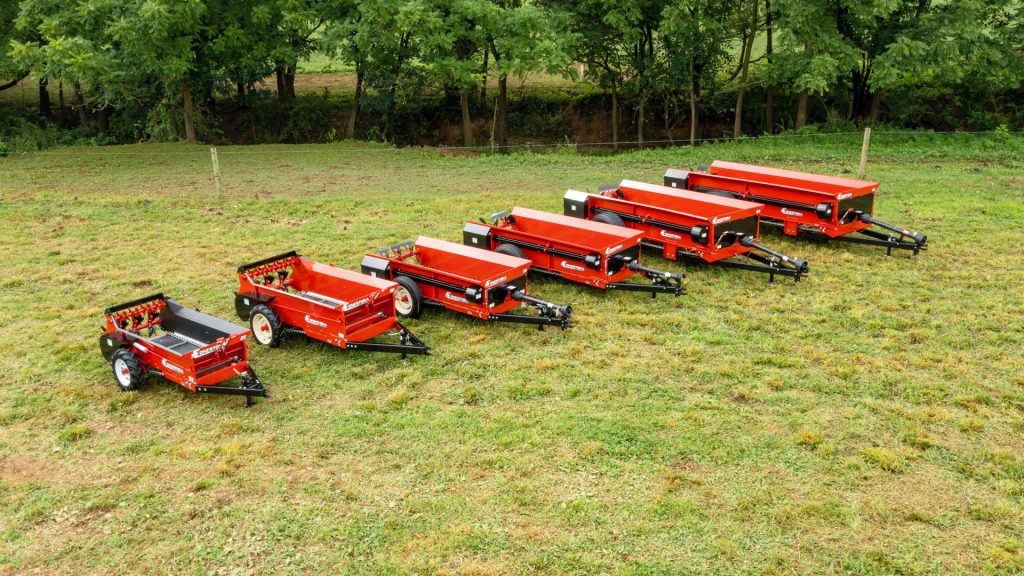
Trying to figure out what size manure spreader will be best for your operation? There are a few critical factors you’ll need to take into consideration. The factors that determine which size manure spreader you should invest in are how many animals you’re spreading for, how often you can or want to spread manure,
You’ll also need to consider size (how much you need the spreader to hold). This can be determined by the size of your operation (how much you will have to spread at one time) and the frequency with which you’ll need to spread manure.
Our 12-gauge steel has a good life balance between the spreader’s box and its working components, so we provide a 10-year warranty on our frames and boxes to prove the point.
Years ago, we began making the apron, both slats and chain, of all models, out of stainless steel to increase apron life up to three times what it was with A36 steel. Stainless steel aprons cost more, but they’re worth it in the apron because it is the heart of the spreader mechanism, and their longer life gives owners three times more downtime-free working hours.
How Long Does A Manure Spreader’s Box Last

If you need a reliable and efficient manure pump for your farm, look no further than Conestoga Manure Spreaders. Our wide range of high-quality manure pumps is designed to meet the demands of modern farming. With our durable and dependable pumps, you can optimize your manure management and ensure smooth and efficient operations. Don’t compromise on the quality of your equipment; check out Conestoga Manure Spreaders today to learn more about our products and how they can benefit your farm. Act now and take your farm operations to the next level.
Quick FAQ
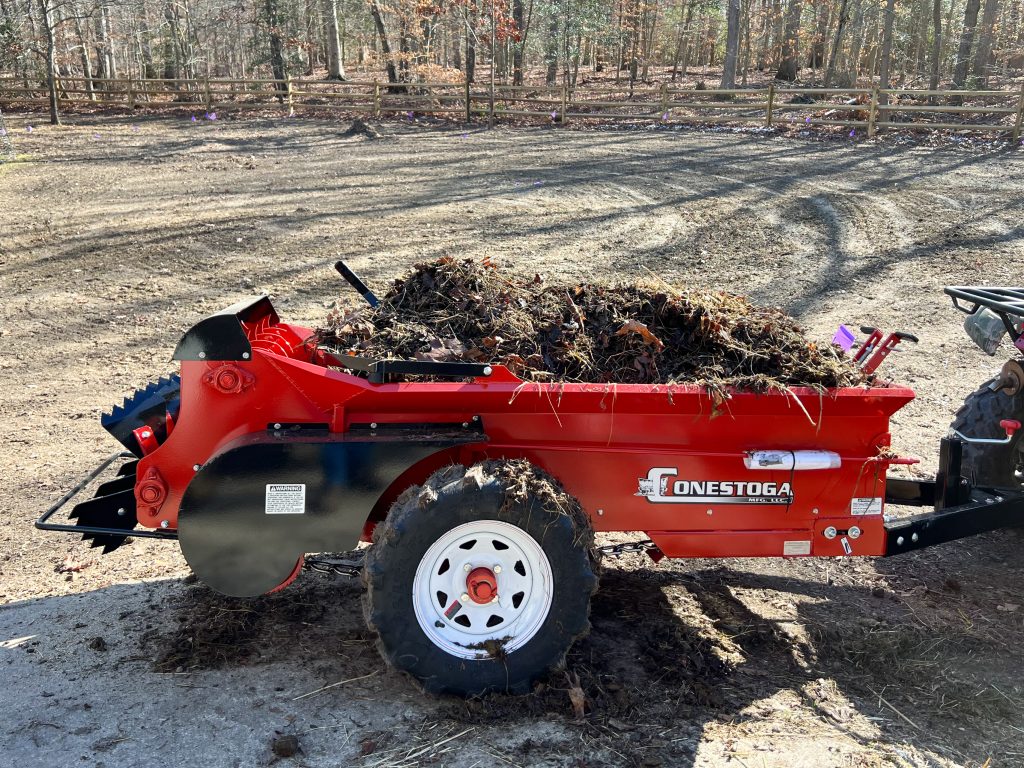
How Many Bushels Can Fit In The Spreader?
Our manure spreaders are measured in cubic feet of heaped capacity, meaning you can heap 25 or 50, or 125 cubic feet of material in the spreader based on its capacity rating. One cubic foot of material in this manure is the same as 0.8 bushels. So, multiply the heaped capacity by 0.8 to get the bushel capacity.
How Long Will It Take To Fill My Spreader?
This depends on how many horses you have. Let us consider the basic facts. An average-sized horse will produce 20 kg of manure per day in the region. The spreader model ES090 is rated at 430kgs, and you have 4 horses. 4 horses multiplied by 20kgs equals 80kgs of manure daily. The spreader capacity is 430kgs, which, when divided by the daily volume, equates to just over 5 days. The volume also plays a part in the calculation, but the above basic facts are a good guide.
How Long Should I Leave The Field Empty After Spreading?
Weather conditions can play their part in the time for the manure to break down, but the above is a good rule of thumb guide. The average time we recommend is 10 to 14 days to allow the manure to break down and dissipate into the ground adequately. See the eco benefits page for photos and further details.
What Can I Use To Pull My Manure Spreader?
- Ground Driven: ATV, UTV, or Tractor
- PTO tractor weight should exceed the total spreader weight on a hill
When Do You Need A Top Beater Bar?
Pen-packed manure, cow manure, manure with a heavy straw content, anything that is dense or thick
Shaven manure, horse manure (generally speaking), dry manure. Shredder bars are not the same as beater bars. Because of Conestoga’s beater paddle design makes a regular beater bar sufficient for spreading most manures.
For more information about manure spreaders, check out our blogs!
